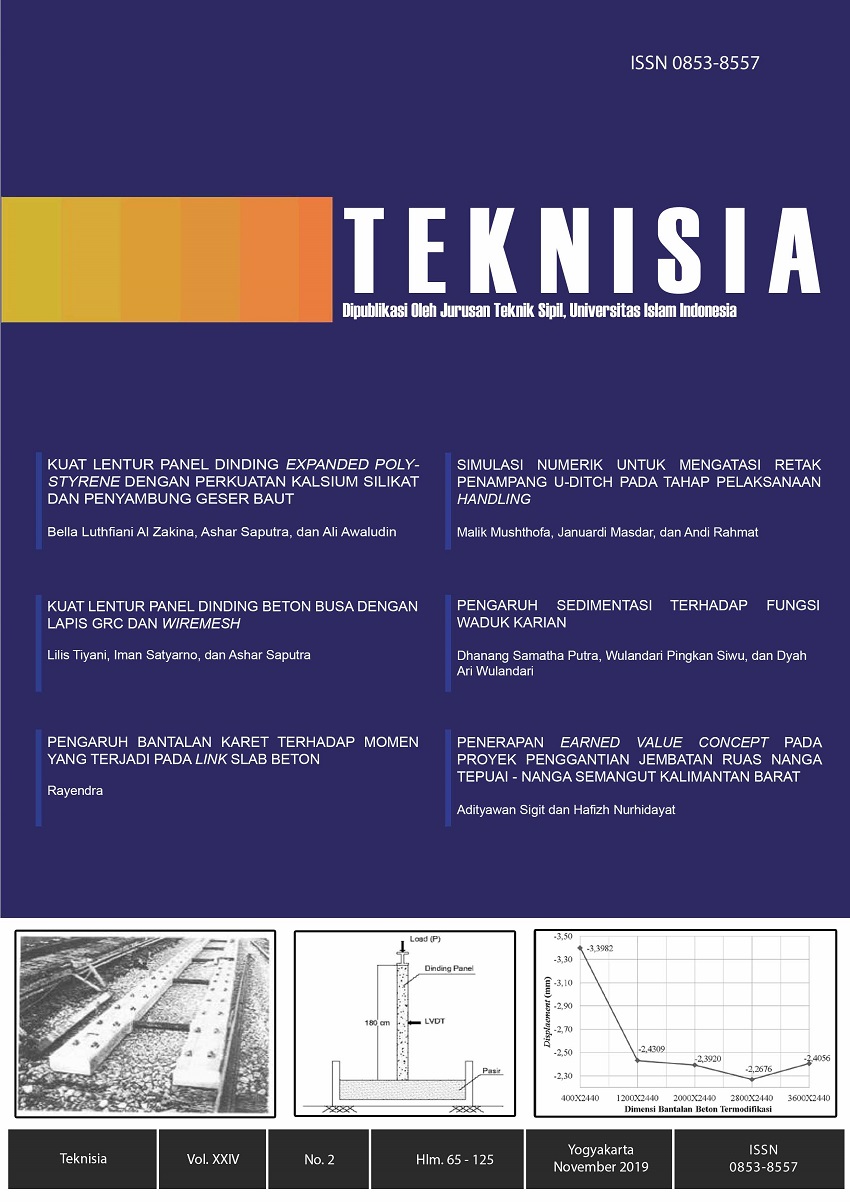Main Article Content
Abstract
The use of link slab as a substitute for expansion joints is one of the innovations that can provide benefits for bridge life, user comfort, and maintenance cost efficiency. Link slab is a slab placed on the upper surface of the adjacent girder end which forms a continuous slab system with the slab deck. In the transition zone, link slab and girder are installed in hard rubber and soft rubber pads at some thick variations in each type of rubber. Moment on the link slab is obtained due to the effect of traffic load according to SNI 1725: 2016 with the condition of the link slab without and with rubber pads. The study of the use of link slab in this paper is carried out in a numerical approach on a finite element software-Abaqus. Link slab is modeled as a 3D solid model in compressive concrete variations. In this study, the addition of hard rubber pads on link slab can reduce the magnitude of moments compared to link slab without rubber pads. This is indicated by the percentage reduction moment between 39,20-83,42% on LS-1, LS-2, and LS-3 hard rubber pads with thichness 10 mm, 20 mm and 30 mm. While on link slab with soft rubber pads is found that moments are greater at the very thick pads This is indicated by the percentage difference in moments between 198,26 – 244,58% on LS-1, LS-2, and LS-3 soft rubber pads with thickness 10 mm, 20 mm and 30 mm. This large difference is due to the effect of moment change from negative moments (initial conditions) to positive moments after the addition of soft rubber pads.
Keywords
Article Details
Under the following term:
-
Attribution — You must give appropriate credit, provide a link to the license, and indicate if changes were made. You may do so in any reasonable manner, but not in any way that suggests the licensor endorses you or your use.
-
ShareAlike — If you remix, transform, or build upon the material, you must distribute your contributions under the same license as the original.
- No additional restrictions — You may not apply legal terms or technological measures that legally restrict others from doing anything the license permits.
References
- Au, Alexander., Lam, Clifford., Au, Jim., Tharmabala, Bala., 2013. Eliminating Deck Joints Using Debonded Link Slabs: Research and Field Tests in Ontario, Ministry of Transportation of Ontario (MTO), Canada.
- BMS, 1992. Bridge Management Systems, Department of Public Works, Indonesia (in Indonesian).
- Badan Standarisasi Nasional, 2016. SNI 1725: 2016 Pembebanan Untuk Jembatan. Jakarta: Badan Standarisasi Nasional.
- Hong, Yu., 2014. Analysis and Design of Link Slabs in Jointless Bridges with Fibre-Reinforced Concrete. Waterloo-Ontario-Canada: University of Waterloo.
- Qian, S., D. Michael, Y. Lepech, Y. Kim, and V.C Li. 2009. ACI Structural Journal. Introduction of Transition Zone Design for Bridge Deck Link Slabs Using Ductile Concrete, l, V. 106, No. 1, January-February 2009: 96-105.
- Mothe, Ram Naren., 2006. Partial continuity in prestressed concrete girder bridges with jointless decks. India : The Department of Civil and Environmental Engineering B.E., Osmania University.
- Sugihardjo,H. 2010. Studi Penggunaan Link Slab Pada Jembatan Komposit. Surabaya: Institut Teknologi Surabaya.
- Sugihardjo, H and Supani. 2009. 1st International on rehabilitation and Maintenance in Civil Engineering (ICRMCE), Solo. Introduction of Repairing and Joining Methods for Simply-Supported Prestressed Bridges Using Link Slab: 66-73.
References
Au, Alexander., Lam, Clifford., Au, Jim., Tharmabala, Bala., 2013. Eliminating Deck Joints Using Debonded Link Slabs: Research and Field Tests in Ontario, Ministry of Transportation of Ontario (MTO), Canada.
BMS, 1992. Bridge Management Systems, Department of Public Works, Indonesia (in Indonesian).
Badan Standarisasi Nasional, 2016. SNI 1725: 2016 Pembebanan Untuk Jembatan. Jakarta: Badan Standarisasi Nasional.
Hong, Yu., 2014. Analysis and Design of Link Slabs in Jointless Bridges with Fibre-Reinforced Concrete. Waterloo-Ontario-Canada: University of Waterloo.
Qian, S., D. Michael, Y. Lepech, Y. Kim, and V.C Li. 2009. ACI Structural Journal. Introduction of Transition Zone Design for Bridge Deck Link Slabs Using Ductile Concrete, l, V. 106, No. 1, January-February 2009: 96-105.
Mothe, Ram Naren., 2006. Partial continuity in prestressed concrete girder bridges with jointless decks. India : The Department of Civil and Environmental Engineering B.E., Osmania University.
Sugihardjo,H. 2010. Studi Penggunaan Link Slab Pada Jembatan Komposit. Surabaya: Institut Teknologi Surabaya.
Sugihardjo, H and Supani. 2009. 1st International on rehabilitation and Maintenance in Civil Engineering (ICRMCE), Solo. Introduction of Repairing and Joining Methods for Simply-Supported Prestressed Bridges Using Link Slab: 66-73.
